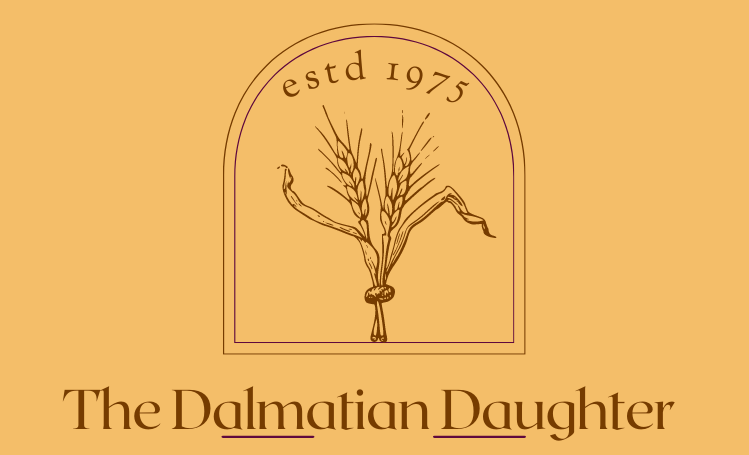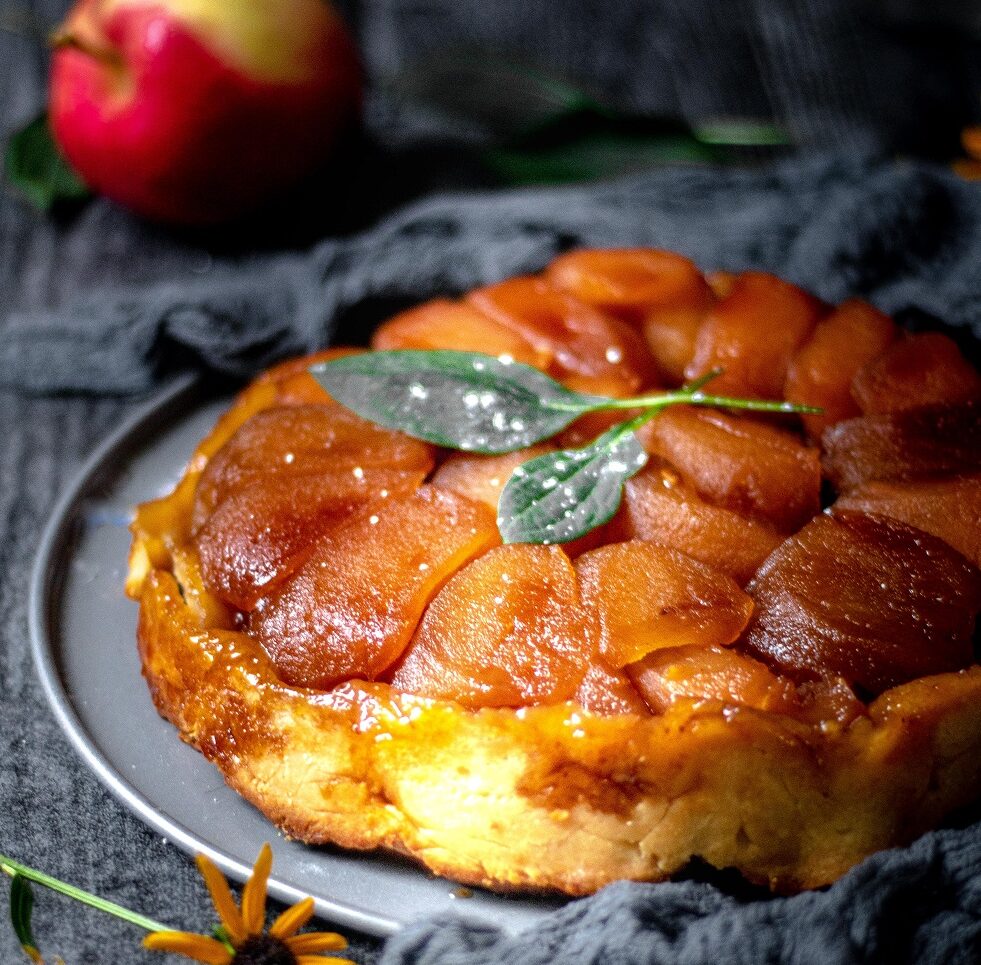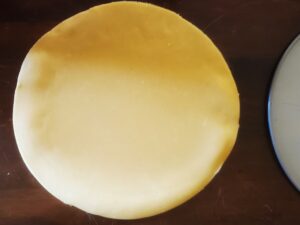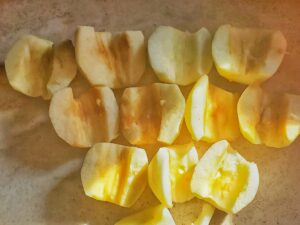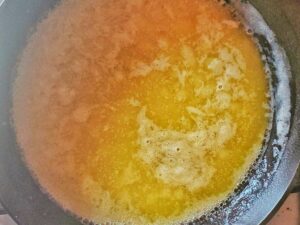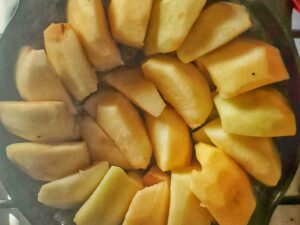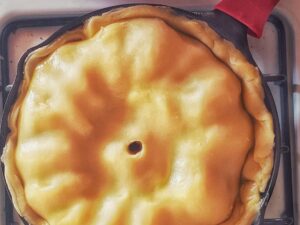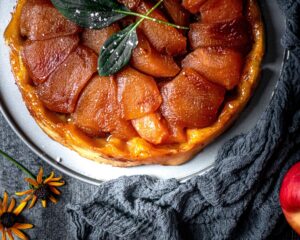Tarte Tatin
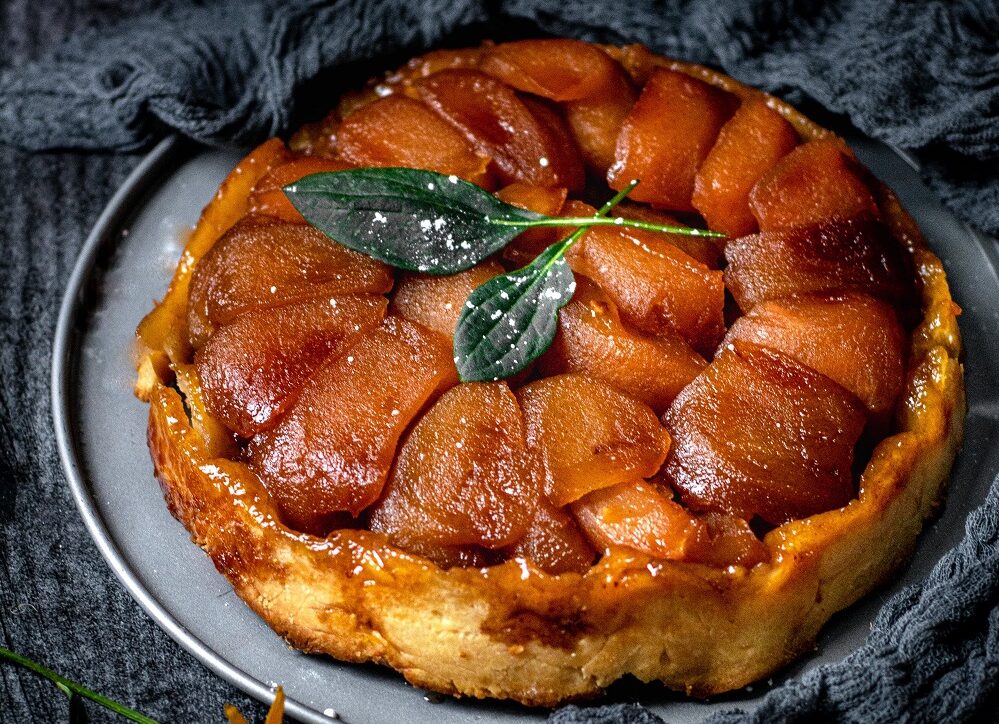
This French technique following Tarte Tatin will make you renounce American apple pie as quickly as you can say “oui oui.” A buttery Pate Sable shortcrust is gently folded over a picturesque structure of curvy apple halves that have been simmering in amber caramel. After baking to a golden brown in the oven, the marvel is then flipped over with a good thought or two, and voila. Autumn personified in a baked good.
As French as Apple Pie
Even though The Storied Spoon prides itself on the history of food and recipes, I am not going to recant the age old tale of how the Tarte Tatin came to be, though I love a good story about two nutty sisters who dropped a dessert on its head and created baking history. This story is about my history of Tarte Tatin, which was nil until recently.
Even as a child, I enjoyed the indulgent bounty that found its way to our oversized, dark wood dining table every Thanksgiving. The feast in question did not, in fact, find its way at all, but via the hands of my mother. She single handedly prepared the holiday turkey, filled to the brim with my grandfather’s gizzard-beef infused stuffing (which he found in the New York Times circa 1950), mashed potatoes, gravy, cranberry sauce, green beans, and a “light salad.” She has a sense of humor, my mother. For dessert, she always whipped out a pumpkin pie, a pecan pie after I begged her for the candy like dessert, and, of course, an apple pie, made from scratch.
Un-American Child
I enjoyed all of my mother’s fine holiday desserts, and apple pie safely held a middle spot in between pecan, my sticky favorite, and pumpkin, which I never really cared for much, despite my love of autumn and all things orange. The apple pie was…good. She hand made her crust, going through a phase of using Crisco and then returning to using butter (there might have been a margarine phase in there too at some point.) Despite the details, her crust was always flaky, even if a bit cobbled here and there, and her Granny Smith apples, mixed with sugar, cinnamon, and lemon juice, were always soft and flavorful. It was all fine, especially with a scoop of vanilla ice cream on top, or whipped cream, but it was somewhat heavy, and predictable, and average, even when great.
Le Changement
(Also known as “Change”) So, year in and year out, I ate the apple pie as it was. I had always been a dedicated fan of cake over pie, and so we stood there, pie and me, with our lackluster feelings for one another. In walks the Turkish American man into my life, the one who spent summers in France as a child. I knew of “Tarte Tatin,” vaguely, but the concept seemed like another option, like a reverse apple pie.
I love caramel and apples, so the more I became adept at making breads, yeast-focused bakes, and embracing the uniqueness and sometimes difficult desserts of my own Croatian heritage, I came closer and closer to the first Tarte Tatin. Somehow, it had escaped me at parties, holidays, restaurants even. It was up to me to introduce it to myself.
Cast Iron
Promises, promises. I kept talking about it. My boyfriend kept expecting it. Once I dove into baking full time, it was solidly etched onto the list. Then, I realized I could not make Tarte Tatin without a cast iron pan (not Really, anyway). Lucky for me, this cast iron pan was voted #1 by the trusted America’s Test Kitchen on PBS, And it was 12″. The bigger, the better. The second one I made a year later was still using cast iron, but I switched to a neat little eight inch version. Much easier to flip, and I still used most of the ingredients, with a little dough left over.
No Excuses
One lovely mid fall Saturday, I decided to make the Tarte Tatin. I knew it was a quick process, but one that I had to prepare all the elements for, ahead of time: the short crust dough, the caramel ingredients, the apples…the APPLES. I lucked out in that I work near a great farmers market in the Upper West Side near Lincoln Center. The Thursday before, when leaving back to Brooklyn, I grabbed about six comically giant Granny Smith apples, nice and dull and without the shine of pesticides. My cast iron pan was on its way. The French formation of apple pie was finally coming to life.
Quick, and Dirty
As said, the prepping is key here. I made the Tarte Tatin at night, after dinner, at about 6pm–late for me, baking wise, to try something new without the safety net of daylight. I am a “by hand” girl, where dough is concerned, but, of late, I have fallen for the ease and uniformity of making pie and tart dough in my food processor. I found a somewhat simple recipe by a French chef and stuck to it. My boyfriend gave me pointers on what it was to look like, and what not to do (he worked for a “French” bistro wherein the crust was a frozen square that the chef dumped caramelized apples onto. It was lackluster indeed, even more so than the American apple pie.)
The Trick
While the dough chilled, I got to the apples, but had help. I have been chopping apples up in a very lazy way through most of my adulthood (straight corners around the core), but my mother, my boyfriend’s mother, and most immigrant based families, know the females in the brood cut fruit towards themselves, even peeling apples with a small paring knife (which I do) instead of a fruit peeler.
The trick is simple: Slice the apple, once peeled, down the middle, then, with said small knife, slice in a U shape towards you as you remove the inner core. The result should be a halved apple that looks like a big smile. My apples were so large, that I ended up quartering most of the slices, but remember that the apples will shrink quite a bit, so pack them in tightly once they go into the caramel.
After my boyfriend flipped the cast iron pan for me with a large platter on top (reversing the placement of the two), he lifted the pan up to reveal the glistening, red-brown-caramel apples. Any formation or pattern looks beautiful. He reminded me it is meant to be a rustic, peasant dessert and not a piece of art. I prefer French foods and desserts that tend towards the former.
Le Thanksgiving
The moment I ate my first bite of the almost-still-too-hot-but-it-was-8pm-so-who cares Tarte Tatin, I felt as if I had been dunked ceremoniously in the purified waters of baptism for a religion so wondrous I have yet to find it. It was nothing like apple pie. The crust was short, and biscuit like, a perfect marriage of butter and flour. The apples held their original farmers market flavor so well, and were made so soft by the deliciously deep caramel, that they melted in my mouth as if they were a pudding. The best part of this insanely life changing moment, was when my boyfriend exclaimed, “and there’s not even any cinnamon in it!” After my face told him the story of my disbelief that the thing could be so delicious, his commentary on apple pie as I knew it was thus: “The Americans got it wrong.”
Please enjoy apples in any way you like – cake, pie, tart, Tatin…I hope this recipe, which took a mere 35 minutes to prepare, and 40 minutes in the oven, finds you well. Don’t be afraid to show up for American Thanksgiving this year with a solid, rust coloured, shimmering plate of Tart Tatin instead of apple pie. You will be thankful, promise kept.
Tarte Tatin
Ingredients
Equipment
Method
- By hand or in a food processor, combine/pulse the flour, sugar, butter and salt together about 10-12 times until uniform and pea sized. Add in the egg yolk and combine/pulse a few times.
- Add in the ice water, a tablespoon at a time, until the desired consistency is achieved. Be careful not to let get too wet, but if you do, you can add in a little more flour when turning out.
- Turn out onto a lightly floured, countertop surface and combine further with your hands, kneading a little bit until the dough comes together in a ball and is softened a bit. Do not overwork.
- Flatten and immediately roll out to an inch or two larger circumference than your pan. Refrigerate for at least 30 minutes.
- Prepare the apples as stated above: Peel and then cut each apple in half. Take a paring knife and cut a half moon/u shape towards you for each half, cutting out the hard portion/core. If apples are too big, slice into quarters after coring.
- In the cast iron pan (or pan with higher sides), add the butter and sugar (gently pour into the butter) together once pan is on a medium-high heat.
- Incorporate the sugar and butter and then LEAVE ALONE. Mixture will slowly bubble and darken. It makes for a better caramel if you do not stir during this process, which can take anywhere from 5-10 minutes.
- Once caramel is Almost your desired color, remove from the heat, stir, and drop in your apples, placing them carefully, core side facing down. You can place in a flower pattern, using one or a few smaller pieces for the center, and/or add in a few thinner pieces if you need to fill in any gaps. It does not have to be picture perfect. The Tatin will take care of itself. Add a pinch of salt over the apples.
- Put the pan back on higher/high heat and cook the apples for another 10-15 minutes or so, making sure to turn the apples over twice–once to coat the other side, and again to ensure that the rounder outer sides are facing up.
- Take the dough out of the refrigerator for a few minutes prior to this point and place the dough over the apples in the pan, tucking in the outer edges around the outer edge of apples. You can make a small air hole in the center.
- Give pan a shake and make sure the caramel is evenly distributed, moving the pan into the oven at 375 degrees. Cook for 35-40 minutes, or until crust is golden brown. The juices will rise around the edges very soon in the baking process.
- Let cool for at least 10 minutes, and, ever so carefully, place a large flat plate/platter on top of the pan. Hold with a kitchen towel or oven mits, along with the handle, and flip (with a prayer). Slowly, raise up the pan from the Tarte Tatin, giving it an extra shake if necessary.
- Allow the tart to cool further, and enjoy room temperature or warm. There is no law in my land about ice cream, creme fraiche, or whipped cream on top, but I honestly think the Tarte Tatin on its very own is one of the most delightful creations for any Thanksgiving or Bastille Day, or Saturday in fall. Enjoy.
